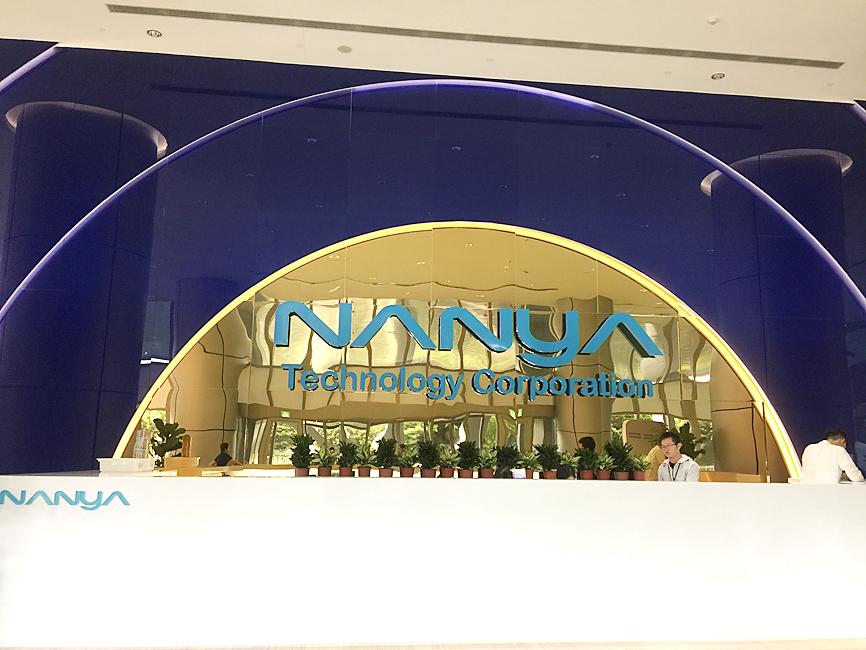DRAM chipmaker Nanya Technology Corp (南亞科技) expects selling prices this quarter to edge downward by a single-digit percentage or remain flat from last quarter as Russia’s invasion of Ukraine and China’s COVID-19 lockdowns add to market uncertainty and dim business prospects.
As Russia’s war against Ukraine prompted raw material costs and shipping fees to surge, and concern has grown over rising inflation, placing a dent in consumer demand for electronics such as TVs, Nanya Technology president Lee Pei-ing (李培瑛) told an online media briefing yesterday.
“On the demand side, smartphone demand did slow a bit. Consumer notebook computers were also affected. High inflation and weaker consumer spending were likely the reasons. Seasonal factors were also behind the slowdown,” Lee said.

Photo: Grace Hung, Taipei Times
Demand for DRAM chips used in cloud-based servers, commercial laptops and gaming computers remains solid, he said.
“From prices in April, it looks like any price decline in the second quarter will be smaller, or even flat, compared with the first quarter,” Lee said. “But, there is a lot of uncertainty. We need to look at the market situation month by month for the rest of the quarter.”
Overall, DRAM prices this quarter are likely to dip by a low single-digit percentage on a quarterly basis, or remain unchanged, after a 5 percent decline in DRAM prices in the first quarter, Lee said.
Before the war, Nanya Technology expected a robust rebound in prices and estimated that DRAM prices would begin to climb in the second quarter.
However, the firm’s shipments in this quarter are likely to resemble the first quarter’s, Lee said yesterday.
The war in Ukraine has not had a significant effect on the company’s chip shipments due to its small exposure to Russia and Ukraine, Nanya Technology said, adding that it suspended shipments to Russia after it invaded its neighbor on Feb. 24.
The lockdown in Shanghai is bringing challenges to the whole supply chain, as customers try to find solutions to transport restrictions in China, Lee said, adding that the lockdown has made it difficult to transport goods in and out of the city.
Lee added that some customers had said that the curbs could remain in place until Monday next week in some districts of Shanghai.
Some customers have destined deliveries to Chongqing, a manufacturing hub for notebook computer makers, or even to Thailand, he said.
Nanya Technology yesterday posted NT$6.55 billion (US$225.47 million) in net profit for last quarter, up 1.5 percent quarter-on-quarter from NT$6.45 billion. That represented annual growth of 142 percent from NT$2.7 billion.
Earnings per share last quarter rose to NT$2.11 from NT$2.08 a quarter earlier and NT$0.88 a year earlier, while gross margin fell for a third straight quarter to 31.4 percent from 37.5 percent in the first quarter.
Construction of a 12-inch fab is to be postponed by two to three quarters due to red tape, Nanya Technology said, adding that the fab would likely begin mass production in 2025, not 2024.
The firm has this year budgeted NT$28.4 billion in capital spending to fund construction and expand capacity, and manufacture its first 10-nanometer class of chips — “10-nanometer class” includes using 10-nanometer to 20-nanometer advance process technologies.

Taiwan’s long-term economic competitiveness will hinge not only on national champions like Taiwan Semiconductor Manufacturing Co. (TSMC, 台積電) but also on the widespread adoption of artificial intelligence (AI) and other emerging technologies, a US-based scholar has said. At a lecture in Taipei on Tuesday, Jeffrey Ding, assistant professor of political science at the George Washington University and author of "Technology and the Rise of Great Powers," argued that historical experience shows that general-purpose technologies (GPTs) — such as electricity, computers and now AI — shape long-term economic advantages through their diffusion across the broader economy. "What really matters is not who pioneers

In a high-security Shenzhen laboratory, Chinese scientists have built what Washington has spent years trying to prevent: a prototype of a machine capable of producing the cutting-edge semiconductor chips that power artificial intelligence (AI), smartphones and weapons central to Western military dominance, Reuters has learned. Completed early this year and undergoing testing, the prototype fills nearly an entire factory floor. It was built by a team of former engineers from Dutch semiconductor giant ASML who reverse-engineered the company’s extreme ultraviolet lithography (EUV) machines, according to two people with knowledge of the project. EUV machines sit at the heart of a technological Cold

TAIWAN VALUE CHAIN: Foxtron is to fully own Luxgen following the transaction and it plans to launch a new electric model, the Foxtron Bria, in Taiwan next year Yulon Motor Co (裕隆汽車) yesterday said that its board of directors approved the disposal of its electric vehicle (EV) unit, Luxgen Motor Co (納智捷汽車), to Foxtron Vehicle Technologies Co (鴻華先進) for NT$787.6 million (US$24.98 million). Foxtron, a half-half joint venture between Yulon affiliate Hua-Chuang Automobile Information Technical Center Co (華創車電) and Hon Hai Precision Industry Co (鴻海精密), expects to wrap up the deal in the first quarter of next year. Foxtron would fully own Luxgen following the transaction, including five car distributing companies, outlets and all employees. The deal is subject to the approval of the Fair Trade Commission, Foxtron said. “Foxtron will be

INFLATION CONSIDERATION: The BOJ governor said that it would ‘keep making appropriate decisions’ and would adjust depending on the economy and prices The Bank of Japan (BOJ) yesterday raised its benchmark interest rate to the highest in 30 years and said more increases are in the pipeline if conditions allow, in a sign of growing conviction that it can attain the stable inflation target it has pursued for more than a decade. Bank of Japan Governor Kazuo Ueda’s policy board increased the rate by 0.2 percentage points to 0.75 percent, in a unanimous decision, the bank said in a statement. The central bank cited the rising likelihood of its economic outlook being realized. The rate change was expected by all 50 economists surveyed by Bloomberg. The